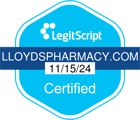Jump to section
Venlafaxine: uses, benefits and side effects
Approved by our Clinical team | Nov 10, 2020

Quick facts
expand_more- Venlafaxine hydrochloride (the full name of the medicine’s active ingredient) was first introduced by the pharmaceutical company Wyeth in 1993.
- It is also known by the brand-names Vensir XL and Efexor XL (among others), and is also available in generic form.
- 4.1 million items of venlafaxine were prescribed by GP surgeries in England in 2017.
What is venlafaxine?
expand_moreVenlafaxine(ven-la-FAX-een) is an antidepressant of the serotonin-norepinephrine reuptake inhibitor (SNRI) class. It is commonly used to treat depression, though it can also be used to treat general anxiety disorder (GAD), panic disorder and social phobia.
In most cases, venlafaxine has fewer unwanted side effects than other antidepressants. In fact, a 2018 study of twelve major antidepressants found it to be the second-most effective antidepressant after amitriptyline.
How does venlafaxine work?
expand_moreAs an SNRI, venlafaxine increase the concentration of the neurotransmitters serotonin and norepinephrine in the brain and body. Serotonin influences mood, sleep and appetite, while norepinephrine (also known as noradrenaline) is used in the body’s ‘fight or flight’ response.
It usually takes four to six weeks for the full effects of venlafaxine to kick in.
Venlafaxine dosage information
expand_moreVenlafaxine comes as modified release tablets and normal tablets, as well as modified release capsules and normal capsules. The available strengths for each of these are 37.5mg, 75mg, 150mg and 225mg.
Most people who take venlafaxine start on a dose of 75mg a day. This can increase gradually to the maximum dose of 375mg a day.
The dose you will be given is the one your GP feels will initially work best for your particular situation. If you have any questions about your venlafaxine dosage, be sure to ask your GP or pharmacist.
How to take venlafaxine
expand_moreTake venlafaxine once a day or twice a day - whichever your GP directed you to do. Ideally, you should have venlafaxine with food so that it doesn’t make you feel sick.
If you think the venlafaxine isn’t working or you are experiencing a prolonged period of side effects, do not give up the medication suddenly. Doing so can cause a range of withdrawal symptoms. Speak to your GP or pharmacist if you have concerns about the effectiveness of your venlafaxine dose.
What are the side effects of venlafaxine?
expand_moreAs an SNRI, venlafaxine has fewer unwanted side effects than other types of antidepressants. However, common side effects happen in more than 1 in 100 people.
Tell your GP if you are experiencing:
- Feeling sick
- Drowsiness and fatigue
- Trouble sleeping
- Mild nausea, diarrhoea, constipation or stomach upset
- Dry mouth
Serious side effects of venlafaxine are less common and happen in less than 1 in 100 people.
Get in touch with your GP as soon as you can if you develop:
- Headaches, balance issues, memory problems, trouble concentrating - these can all be signs of low sodium levels
- Unexplained muscle pain or weakness
- Chest pain, tightness in the chest or a fast or irregular heartbeat
- Shortness of breath
- Severe dizziness or fainting
- Thoughts about self-harm
- Any symptoms of abnormal bleeding (coughing blood, blood in your urine, bleeding gums or bruises on your body with no apparent reason)
- Abrupt changes in your period (heavy bleeding, bleeding between periods, spotting etc.)
It’s worth noting that this is not a comprehensive list of venlafaxine side effects. For a full list check your patient information leaflet, or speak to your GP or pharmacist for more information.
Venlafaxine interactions
expand_moreThe active ingredient in venlafaxine can interact with a number of other medicines.
Do not take venlafaxine with the following medicines:
- Monoamine oxidase inhibitor (MAOI) antidepressants. Do not start venlafaxine within two weeks of stopping an MAOI, and do not take an MAOI within seven days of stopping venlafaxine.
- Drugs for weight loss, such as phentermine.
Taken alongside venlafaxine, the following medicines may trigger side effects:
- Warfarin
- Any medicines that increase drowsiness, such as lorazepam or diphenhydramine
- Anti-inflammatory medicines such as aspirin, ibuprofen or naproxen, as they may increase the risk of bleeding
Before starting a course of venlafaxine, be sure to let your GP know if you are already taking any medicines, vitamins or supplements. A full list of interactions with venlafaxine can be found on the NICE website.
Who can and cannot take venlafaxine
expand_moreThere are certain instances when it may not be suitable to take venlafaxine.
Speak to your GP if you:
- Have had an allergic reaction to venlafaxine or another medicine in the past;
- Have a heart condition, as venlafaxine can affect your heartbeat;
- Have had a eye problem called glaucoma. Venlafaxine, like some other antidepressants, can increase the pressure on your eye.
Your GP will weigh up the situation and suggest treatment that best meets your situation.
Taking venlafaxine during pregnancy or while breastfeeding
expand_moreIf you are pregnant or are planning a pregnancy, it’s important to keep your GP in the loop. Although generally safe for pregnant women, venlafaxine can has been linked to a very small increased risk of problems for unborn babies.
If you are suffering from depression, anxiety or panic disorder, it’s important to treat your condition during pregnancy. That’s why it’s vital that you consult your GP about the treatment - they will advise you of the risks and together you can make the best decision for you and your baby.
Venlafaxine is generally safe to use if you’re breastfeeding, though small amounts can pass into the breastmilk. If you’re taking venlafaxine while breastfeeding and notice that your baby is unwell, speak to your health visitor or GP.







